Pergamon (3)
Q18986Pergamon (Greek: τὸ Πέργαμον; Latin Pergamum): city in Teuthrania, famous for a sanctuary of Asclepius, important during the Hellenistic age under the Attalid dynasty. Modern Bergama.
Attalus II: Consolidation
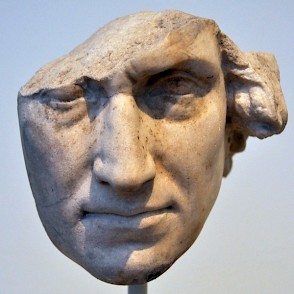
Attalus II Philadelphus ("the man who loves his brother") succeeded to the throne of his brother Eumenes II Soter and married his wife Stratonice in 159 BC. He was acting as regent for Eumenes' young son Attalus III, who would have to wait for twenty-one years until he would rule.note
Attalus II inherited a large kingdom with a flourishing cultural life and without real enemies, although Rome did not want the kingdom to expand its frontiers much more. This did not exclude intervention in other states, though. In 158, the Seleucid king Demetrius I Soter, who was not really popular in Rome, helped Orophernes II, become ruler of Cappadocia, and Attalus brought back Ariarathes V Eusebes, the original king (and brother of Stratonice). The Roman Senate accepted it by claiming all credit.note
Between 156 and 154, Attalus successfully waged war against Prusias II the Hunter of Bithynia, although he took care to keep the enemy's kingdom intact. In 149, he intervened again, helping prince Nicomedes II Epiphanes to become king. Between these two interventions, Attalus was one of the supporters of the coup d'état of Alexander I Balas in the Seleucid Empire. (The others were king Ariarathes V of Cappadocia, the Egyptian king Ptolemy VI Philometor, and Rome.) In 147, Pergamon was one of the Roman allies when it suppressed the revolt of a man named Philip, who had claimed to be a descendant of the last king of Macedonia; Pergamene troops also fought against the Caeni, a Thracian tribe behind Byzantium.note
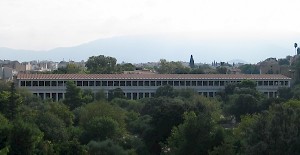
In short, Attalus II did not expand the kingdom itself but expanded his influence. Lavish expenditure in other cities was another way to achieve this. Athens, for example, received a beautiful stoa. Pergamon itself received a new temple of Hera Basileia, which rose above the lower agora and the gymnasium. To pay for all this, all kinds of taxes were used, but a good king also sought to improve trade, for example by building markets and creating save ports. Attalus founded Attaleia, modern Antalya, in the southern part of his kingdom.
Attalus III: Demise
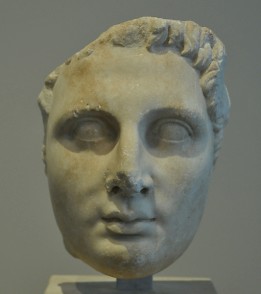
The last Attalid king of Pergamon was Attalus III Philometor, the son of Eumenes II. He succeeded his uncle in 138 and appears to have been rather impopular. In his fifth year, he died of a disease and bequeathed, in order to prevent a civil war, the kingdom to the Romans.note
The civil war, however, was inevitable, and led to a Roman intervention. Attalus' half-brother Aristonicus, the son of king Eumenes II Soter and a dancer,
occupied Asia, which had been bequeathed to the Roman people and was supposed to be free. Consul Publius Licinius Crassus, who was at the same time pontifex maximus (something that had never happened before), set out against him from Italy, but was defeated and killed in battle. Consul Marcus Perperna, however, accepted the surrender of the defeated Aristonicus.note
This was the end of Pergamon as an independent state. In 129, it was reorganized as a Roman province, called Asia; other parts, like Pamphylia, were declared independent. To stress that the days of Pergamon were really over, the new capital was Ephesus.
Roman Province
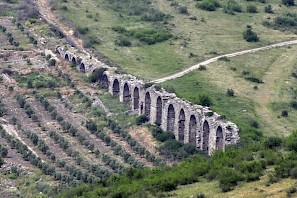
The annexation of Asia was not uncontested. In the northeast, in the kingdom of Pontus, Mithridates VI Eupator organized resistance against the new masters and could count on the sympathy of, among others, the Pergamenes. Their city had suffered from the Roman take-over, for example because its famous sculptors had resettled in Aphrodisias in the south.
Rome, which was focused on domestic affairs (the Social War), was unprepared for the general insurrection in Asia (89/88) and Mithridates started the war spectacularly successful: within weeks, he conquered all of Rome's Asian possessions, hardly encountering resistance. However, the Romans fought back and in 85, general Sulla restored the status quo.
Pergamon's fortunes were restored in the next decades, largely because of one man, Diodorus Pasparus, who was already during his life recognized as some kind of "second founder" of the city and received heroic honors in a heroön. One of the buildings that was added to the city in these years, is the Western Bathhouse on the citadel. That the city was still prosperous, can also be deduced from the fact that it could be looted. The statues that had been erected to commemorate the Galatian victory (the Dying Gaul and the Galatian Suicide) were transported to Rome, where they decorated the Gardens of Julius Caesar, while Mark Antony sent the books of the Pergamene library to Alexandria.
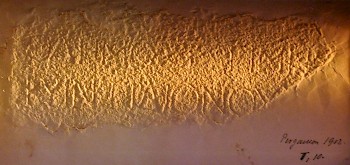
Real recovery came when the Roman Empire, under the emperor Augustus, recovered from the civil wars. Several senators are known to have visited Pergamon; an inscription mentioning Publius Quinctilius Varus survives as a squeeze.
Trade flourished, the city was expanded, an aqueduct became necessary, and a bridge was built across the Silenus. A forum was built, a temple was dedicated to Sarapis (the "red basilica", which survived as a church), and there was also a Roman theater, an amphitheater for gladiatoral games, and a stadium for athletic contests. The ruler cult was renewed: the old heroön, originally built for the Attalid dynasty, was renovated in 29 BCE, and became the main center of the Asian imperial cult.
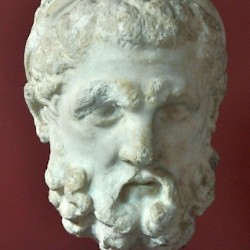 Pergamon, Head of Heracles |
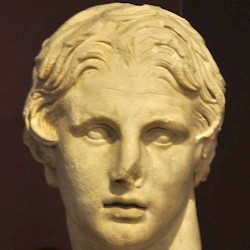 Pergamon, Portrait of Alexander the Great |
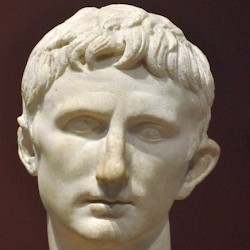 Pergamon, Portrait of Augustus |
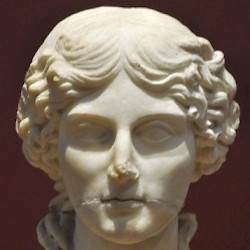 Pergamon, Portrait of Agrippina Maior |
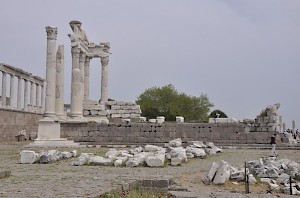
More than a century later, a second temple for the ruler cult was added: it was dedicated to Trajan and dominated the citadel. The main sanctuary of Pergamon, however, remained the old temple of Asclepius, the Asclepium. In the Roman age, it was expanded and became one of the main cultic centers of the ancient world. There was a dormitory, where people would have dreams that offered suggestions for the cure; other elements of the complex were a large treatment hall and a theater, because it was believed that listening to music could help medical treatments.
One of the doctors working over here was Galen, who was to become the personal physician of the Roman emperors Marcus Aurelius, Commodus, and Septimius Severus. His works survive and are among the main sources about ancient medicine. One of the patients was the orator Publius Aelius Aristides (117-187), who collected his dreams and published them (the Sacred Tales).
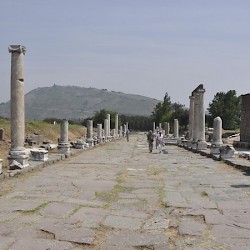 Pergamon, Asclepium, Road to the citadel |
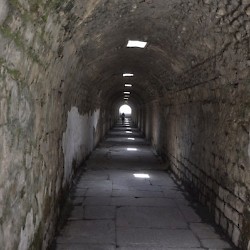 Pergamon, Asclepium, Tunnel |
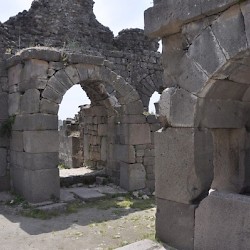 Pergamon, Asclepium, Treatment hall |
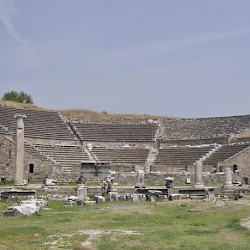 Pergamon, Asclepium, Theater |
In 193-194, Pergamon briefly suffered from the civil war between Septimius Severus and Pescennius Niger, but that was the only real interruption of an essentially quiet age. Even in the third century, when the Roman Empire was in a crisis, Pergamon remained sufficiently wealthy to continue to build new monuments, like the Eastern Baths. In spite of religious changes, the sanctuary of Asclepius remained intact. The Platonic philosophical school was still functioning in the fourth century, when prince Julian, the future emperor, read philosophy in Pergamon.
Christianity and Late Antiquity
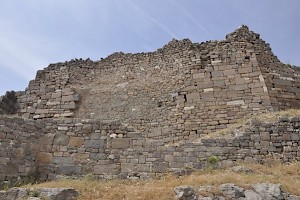
Pergamon is mentioned as one of the seven churches of the Revelation.note The author praises the Christians in the city because of their steadfastness, even though they had been persecuted and a man named Antipas had been killed. Still, the faithful are adhorted to be more careful about sacrificial meat. Interesting is the reference to the "throne of Satan" that is in Pergamon. Although it is often said that this refers to the Pergamon Altar, it may as well be a reference to the sanctuary of the ruler cult. Given the background of Revelation, religious persecution because the Christians had refused to burn incense for the emperor, this may be the more plausible explanation. Several other martyrs are known (Papylus, Carpus, Agathonice) but the sources contradict each other.
In the fourth century, Christianity became increasingly popular and the temple of Sarapis was converted into a church, dedicated to Saint John.
In Late Antiquity, the city was much smaller than it had been in the two first centuries of our era. However, the citadel was still occupied, and was fortified by the Byzantine rulers. In 716, the Arabs briefly held the city, but it was reconquered and remained a Byzantine possession for the next centuries.